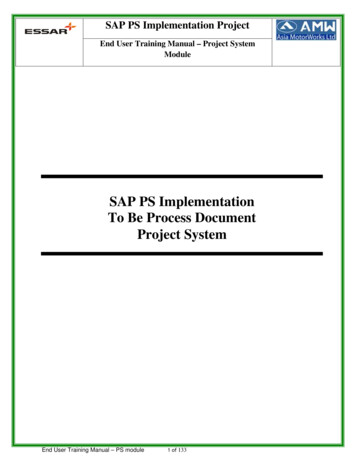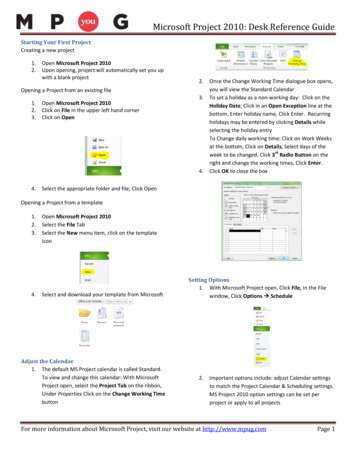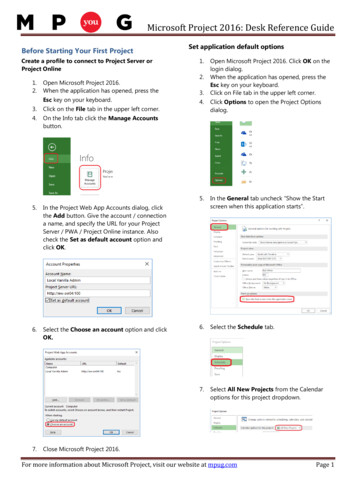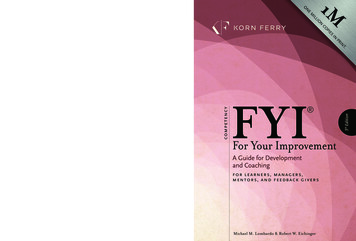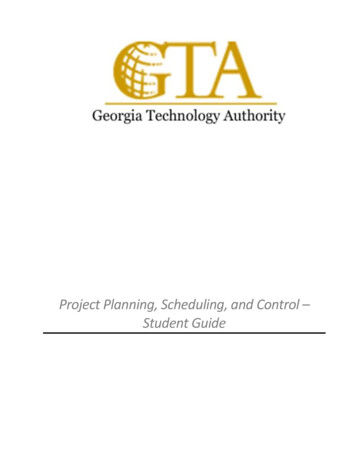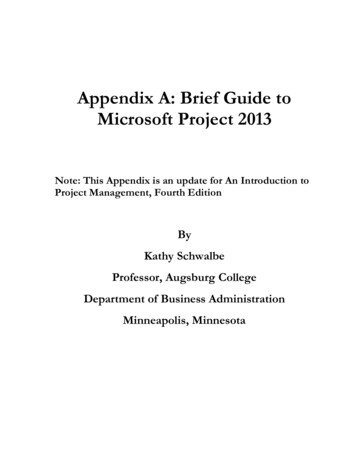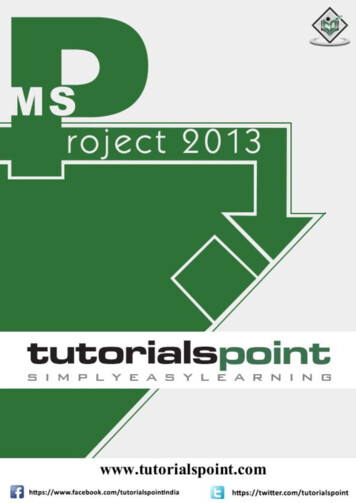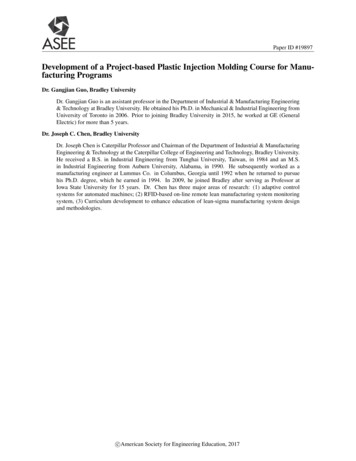
Transcription
Paper ID #19897Development of a Project-based Plastic Injection Molding Course for Manufacturing ProgramsDr. Gangjian Guo, Bradley UniversityDr. Gangjian Guo is an assistant professor in the Department of Industrial & Manufacturing Engineering& Technology at Bradley University. He obtained his Ph.D. in Mechanical & Industrial Engineering fromUniversity of Toronto in 2006. Prior to joining Bradley University in 2015, he worked at GE (GeneralElectric) for more than 5 years.Dr. Joseph C. Chen, Bradley UniversityDr. Joseph Chen is Caterpillar Professor and Chairman of the Department of Industrial & ManufacturingEngineering & Technology at the Caterpillar College of Engineering and Technology, Bradley University.He received a B.S. in Industrial Engineering from Tunghai University, Taiwan, in 1984 and an M.S.in Industrial Engineering from Auburn University, Alabama, in 1990. He subsequently worked as amanufacturing engineer at Lummus Co. in Columbus, Georgia until 1992 when he returned to pursuehis Ph.D. degree, which he earned in 1994. In 2009, he joined Bradley after serving as Professor atIowa State University for 15 years. Dr. Chen has three major areas of research: (1) adaptive controlsystems for automated machines; (2) RFID-based on-line remote lean manufacturing system monitoringsystem, (3) Curriculum development to enhance education of lean-sigma manufacturing system designand methodologies.c American Society for Engineering Education, 2017
12017 ASEE Conference – Engineering Technology Division, Columbus, OH, USA, June 25-28, 2017Development of a Project-based Plastic Injection Molding Course for ManufacturingProgramsGangjian Guo1 and Joseph C. Chen21Assistant Professor2Caterpillar Professor and ChairmanDepartment of Industrial & Manufacturing Engineering & TechnologyBradley University, IL, 61625, USAAbstractBradley University plays an important role in educating ABET accredited manufacturingengineers to major industries, such as Caterpillar or John Deere nearby. In recent years, ourconstituencies have voiced that plastics product design and injection molding process beconsidered key competences in our manufacturing curriculum. It’s always crucial and beneficialfor plastics engineers to understand the whole picture of plastics product development, from theproduct conceptual design to the product validation. Therefore, the curriculum is structuredaround this goal with (1) seventeen lectures covering the fundamental theories of plasticmaterials, design principles such as design for manufacturing (DFM) and design for assembly(DFA), injection molding technologies, etc., (2) computer aided design (CAD), computer aidedengineering (CAE), computer aided manufacturing (CAM), and injection molding lab sessions,and (3) hands-on four-module projects where students can apply the learned knowledge and gothrough each step of injection molded product development. The four-module project includesthe injection molded plastic part design module, the Moldflow simulation module, the molddesign and fabrication module, and the injection molding module. To enhance students'communication, collaboration, and project management skills, 4-5 students, as one group, arerequired to complete the project that requires many different skills such as design, computersimulation, CNC machining, injection molding, etc. After a year of implementation, evidencedemonstrates that the program effectively enhances students’ understanding and capability ofplastic product development. By implementing this new curriculum, Bradley University has beenable to have a higher impact on the career preparation of the students and the supply of trainedplastics engineers to local industries. The presentation will illustrate the plastics injectionmolding curriculum and describe one of the successful four-module projects conducted based onthe curriculum. The impact to students, industries, and the faculty will also be discussed.1. Background and Introduction1.1 Motivation for developing a plastics injection molding courseAs a mid-sized private regional university, Bradley University (BU) plays an important role ineducating ABETS accredited manufacturing engineers to major industries, such as Caterpillar or
2John Deere nearby. Our manufacturing curriculum is focused on metals and their differentprocesses. However, plastics, as one of four engineering materials (i.e., metals, ceramics,plastics, composites), have been widely used in all industries. Their yearly consumption hassurpassed the other three [1]. To meet the industry megatrend, our constituencies in recent yearshave voiced that plastics product design and injection molding process be considered keycompetences in our manufacturing curriculum. Under such circumstance, a plastic injectionmolding course was developed and offered in the Spring semester of 2016, to expand students’experiential learning, enhance students’ competitiveness and meet the industrial growing needsfor plastics engineering professionals.1.2 Learning objectives of the plastic injection molding courseDeveloping a new course starts from asking the question: “What do I want my students to learnfrom the course?” The goal is to help students to enter the field of plastics injection moldingquickly with the fundamental knowledge base and necessary hands-on skills. The specificobjectives of this course are: To understand plastic materials (basic resins, structures, physical, mechanical andthermal properties).To become familiar with a variety of plastics processing technologiesTo understand injection molding process, material selection, and the structure andfunctions of an injection molding machineTo understand injection molded plastic part design and be able to apply 3D modelingand 2D engineering drawingTo be able to use Moldflow simulation software to improve part design through avariety of analyses such as cooling analysis, gate location, warpage, etc.To develop skills for mold design, generate toolpath (CNC codes) in Mastercam, andcomplete mold fabrication on a CNC milling machine with the codesTo develop skills for injection molding process parameters setup and optimizationTo understand the common defects of injection molding and develop troubleshootingknowledge and skillsTo understand a variety of advanced molding technologies (over-molding, gasassisted molding, foam injection molding, micro-injection molding, co-injectionmolding, insert molding, etc.)To provide students with an appreciation of problems and perspectives inenvironmental, life cycle and recycling aspects of plastics use.1.3 Course design to achieve the learning objectivesIn the literature, learner background knowledge was found to have a significant influence onlearning outcomes [2-5]. Depaolo et al [3] concluded a positive relationship between studentbackground knowledge and learning outcome in business statistics and calculus, and their resultsrevealed that the students without background knowledge in calculus had negative attitudes andpoor exam performance. Hailikari et al [4] studied the relationship between student backgroundknowledge and achievement in an introductory chemistry course, and their results demonstratedthat the students who had a deeper level of background knowledge were more likely to finish the
3course successfully with higher final grades. Before taking this course, our students have littlebackground knowledge in plastics and plastics processing, as our manufacturing program has notoffered plastics related courses yet. Our students have background knowledge in CAD design,and machining, which is very helpful to succeed in this course. One of the challenges for thecourse design is how to deliver the fundamental plastics knowledge of plastics quickly within a16-week semester. Another challenge is that there is no appropriate textbook available to coverthe topics.This three-credit plastics injection molding course, which is comprised of the following items:(1)Seventeen 75-minute lectures for learning the fundamental theory and principles ofplastic materials, characteristics of plastic part design, materials selection, design formanufacturing (DFM) and design for assembly (DFA),(2)One 75-minute CAD modeling lab session for re-sharpening the 3D modeling skillsstudents learned from previous course, and for applying plastic part design principles(uniform thin wall, draft angle, etc.) to the parts(3)Two 75-minute simulation lab sessions for learning the commercial software Moldflow,to implement all sorts of analyses such as gate location analysis, molding windowanalysis, fill/pack analysis, cooling analysis, etc., to ensure the designed parts have agood mold-ability.(4)Two 90-minute injection molding lab sessions for learning injection molding machineoperation, parameter settings, mold installation and alignment, etc.The sequence of learning is important. Students usually need to know some course contentbefore they can move to another advanced topic or start another project stage. The lectures andlab sessions are arranged based on the requirements of the four-stage project mentioned below,which would help students acquire knowledge and have the opportunity to apply at the righttiming.1.4 Assessing students’ learning with hands-on project, homework assignments, and examsProject-based learning (PBL) is a student-centered pedagogy, and it involves a dynamicclassroom approach in which students obtain a deeper knowledge through active exploration ofreal-world challenges and problems [6]. PBL is particularly helpful for engineering students.Students learn about a subject by working for an extended period of time to investigate on acomplex question, challenge, or problem [6]. Therefore, a four-stage project is required forstudents to develop an injection molded product, which starts from product conceptual design,developing detailed 3D models and 2D engineering drawing, conducting Moldflow simulation toimprove the design, applying Mastercam to generate CNC tool path for mold fabrication,installing the mold and machine setup, fabricating the parts, inspecting the quality, and writing aself-reflection report to summarize the learning and analyze how to improve the quality andeliminate molding defects with what students learned from troubleshooting techniques inclassroom. This project reflects the entire cycle of injection molded part development, so thatstudents will have a whole picture on how plastics parts are made from customer needs to
4market. Apart from the hands-on project, ten homework assignments and two exams are used forassessing students’ learning outcome. As shown in Figure 1, the project contains the followingstages:(1)Stage 1: Injection molded plastic part design(2)Stage 2: Moldflow simulation of designed parts(3)Stage 3: Mold design and fabrication with a CNC milling center(4)Stage 4: Injection molding of designed partsThe organization of this paper is as follows: This project-based plastics injection moldingcurriculum model will be demonstrated in the next section, followed by a case study of a studentteam project conducted. Finally, conclusions and discussions of future curriculum improvementstrategies will be presented.Stage 11 WeekPart Concept & Design brainstormingand --------------------------3D Solid modeling for plastic partdesign/ Creo 2.0 and Inventormodeling software are usedStage 23 WeeksUse Autodesk Moldflow software tosimulate plastic flow of 3D solidmodeled part/ analyze results ofAutodesk Moldflow and identifypotential -----------------------Mold inserts design/ Import 2DStage 33 Weeksdrawing of the plastic part toMastercamX8/ set tool selection/define tool paths and set machineparametersExtract G-Code from MastercamX8Insert G-Code into the CNC Millingmachine/ Perform stock set up andmachine the 2 mold ------------------------Set up mold inserts on the injectionStage 42 Weeksmolding machine/ Prepare machinefor Test Cycle injection moldingVary process parameters until desiredparameters are achievedFigure 1. Four-Stage Project of Injection Molded Part Development
52. Overview of Injection Molding ProjectThe purpose of the project is to encourage students to apply the knowledge and theory learned inclassroom, to develop an injection molded plastic part. Through the project, students got trainedin the entire product development stages for injection moldings. They were able to integrate awide range of knowledge and skills to complete the project, including but not limited to partconceptual design, 3D modeling and 2D engineering drawing development, Moldflowsimulation, tooling design, CNC toolpath generation in Mastercam, molding machine setup andparameter optimization, and fabrication. To enhance students’ communication and collaborationskills, they were grouped together and each group had 4-5 students. To be creative, they aregiven complete freedom to either design a new plastic part or modify an existing plastic part. Theoutcome of the project is summarized in the following.Stage 1: Injection Molded Plastic Product DesignBefore the beginning of Stage 1, the powerful Axiomatic Design tool was introduced to students[7]. Design is an interplay between what we want to achieve and how we achieve them. It isbasically a mapping process among four domains, as shown Figure 2. It is expected that thisimportant concept was rooted into students’ brain – every design starts from the customer needs.The conceptual design is a mapping process between the functional requirements of the productand the customer needs [7].Figure 2: Four Domains for Design MappingProcessApart from learning the Axiomatic Design tool, the students learned the plastic part designprinciples, DFM (design for manufacturing) and DFA (design for assembly), in the classroom.
6These principles include uniform wall thickness, cooling time estimation, draft angle for partejection, reinforcing rib design, boss and gusset design, undercut, smooth transition at corners,snap-fit design, hinge design, etc. These principles are critical to the design of injection moldedparts. For example, if draft angles or undercut was not taken into consideration, part ejectionissues would occur during processing. Other important concepts such as uniform part thickness,shrinkage calculation, warpage issues and causes, were delivered with classroom lectures, so thatstudents can apply these concepts and principles to their design, to avoid costly mistakes.After grasping these important design principles and concepts, the injection molding studentteam collaborated to develop a conceptual design. This activity allowed the student team togather information about the constraints and limitations of the injection molding machine, suchas shot capacity and clamping tonnage. Based on the collected information, the student team wasable to conceptualize the part they wanted to fabricate. After coming up with the basic idea, thestudent team then had to brainstorm how to design the part considering certain attributesassociated with injection molded parts such as shrinkage and warpage. This is especiallyimportant because misinformation can lead to a defect. Taking all this information into account,the student team was able to create a 3D model and a 2D engineering drawing of the plasticwrench, as shown in Figure 3. The wrench is designed to function as a removing tool for 3/8” ahex cap. It is small and lightweight to fit comfortably, but will function at the light workloads.The part thickness will allow for flexibility in the non-functional direction but remain relativelyrigid under use. The raised text will allow for more grip and an easy identification means whichis designed to last for the lifetime of the partFigure 3. 3D Model and 2D Engineering Drawing of a Plastic Wrench
7Stage 2: Moldflow SimulationMoldflow Simulation Adviser is a commercial powerful software that provide simulation toolsfor injection mold design, plastic part design, and the injection molding design process. It hasmany functions that can be used to determine the mold-ability of designed part and help improvethe design. It is widely used in injection molding industry. Through two 75-minute simulationlab sessions on Moldflow, students were able to grasp the basic skills and conduct thefundamental analyses, such as gate location analysis, cavity filling analysis, packing analysis,sink mark analysis, warpage analysis, and molding window analysis. After importing 3D partmodels, the program simulates the flow behavior of the plastic material during the moldingprocess, and provides you with important data such as cycle time, if the mold will fill, and wheredefects are likely to occur. Through simulation setup and result interpretation, the student teamwas able to see how changes in materials, geometry, and gate location can affect themanufacturability of their designed part. Upon reviewing the results of the simulation, thestudent team was able to optimize their design and run the simulation again with their redesignedpart. Performing such simulation analyses enables students to improve their design and verify themold-ability of the part.Stage 3: Mold Design and FabricationOnce finalizing the part design with the mold-ability verification of Moldflow simulation, thestudent team was able to use Mastercam (i.e., computer aided manufacturing software) to createthe CNC G-codes to cut the mold inserts. Mastercam is the most widely used CAD/CAMsoftware package in the world. It has a comprehensive set of predefined toolpaths—includingcontour, drill, pocketing, face, peel mill, engraving, etc. Mastercam enables machinists to cutparts efficiently and accurately. In the prerequisite course, students already learned Mastercamprogramming. This project gives them an opportunity to refresh and apply Mastercam skills tocut a real aluminum mold. Different cutting tools (endmill, ball endmill, and engraving tools formachining) were selected and used to cut the mold cavity in a Haas CNC Vertical MachineCenter. Figure 4 shows the toolpath generated by Mastercam and the associated G-codes will betransferred to the Haas CNC milling machine to cut the mold inserts.Figure 4. Toolpath and G-codes Generated in Mastercam
8Mastercam also allows users to visualize what their mold will look like based on the toolsand toolpaths they choose. A visualization of the toolpath used in Mastercam is shown inFigure 5.Figure 5. Toolpath and G-codes Generated in MastercamFigure 6 shows that the mold insert was being cut on the Haas CNC milling machine with Gcodes generated by Mastercam. The fabricated mold inserts are shown in Figure 6.In this stage, the student team was able to apply Mastercam programming skills andCNC hands-on machining skills to make their mold inserts, which would be used in the nextstage.Figure 6. HAAS CNC Milling Machine Was Used by Students to Cut the MoldInserts
9Stage 4: Injection Molding of Designed PartsFigure 7 shows that an ENGEL E-victory 30 injection molding machine was used to trainstudents and help them to complete their projects. Two 90-minute injection molding lab sessionswere offered for students to learn the basic operation of the injection molding machine, moldingparameter settings, mold installation and alignment. After the training, the student team was ableto use the machine independently to complete their project.Before using the machine, the student team had to review data provided in the lectures and bytheir Moldflow Simulation analyses, so that they could set up the injection molding machinecorrectly. Figure 8 shows the mold insert installation, alignment and setup. To set up the propermolding parameters, a gate seal study was conducted. The first several parts which wereproduced with the mold revealed some flash defects, but the defect was resolved by slightlyadjusting molding parameters such as injection speed and shot size. The vents located on themold properly served their purpose and performed well, which resulted in a very wellpacked/molded part with uniform geometry, no defects, and great quality. The team then testedvarying shot sizes, clamp forces, cooling times, and injection speeds to determine the optimalparameters for producing their part. Figure 9 shows one of injection molded parts the teamproduced.Figure 7. ENGEL E-victory 30 Injection Molding Machine Usedin Training and Project CompletionDuring this stage, students learned mold installation, alignment, and setup. They were able to setup the proper molding parameters based on their Moldflow simulation results (i.e., moldingwindow) and a gate seal study. The common molding defects and their root causes wereintroduced in the classroom lectures. Students were able to apply the knowledge to analyze andresolve the defect issues. Hereby, some troubleshooting skills were developed to eliminatemolding defects, based on the lectures and hands-on practice.
10Figure 8. Mold Insert Installation, Alignment and SetupFigure 9. Injection Molded Plastic Wrench3. Reflections on the plastics injection molding courseIn addition to the team project results, each student is required to submit an essay discussingabout what he or she learned through the plastics injection molding project. Everyone enrolled inthe course stated that the plastics part molding project is the greatest way of applying theprinciples and concepts learned in the classroom, and they learned most from the project. Someof the students’ comments are shown in Table 1.
11Table 1. Comments from Students about the Plastics Injection Molding Project1The plastic injection mold project was very interesting as well as entertaining. Itchallenged us to apply the knowledge that we’ve gained throughout the duration of thecourse2The best part about this class I believe is the plastics molding project. This made meapply many of the principles that I learned throughout the semester. Everything from partdesign and mold design, to packing time analysis.3This course has showed me how many steps it takes to design molds even for thesmallest simple parts. I have also learned the use of mold flow analysis to streamline themold design process.4Overall I have learned a lot about injection molding through the course project. I wouldrecommend this course to future students. In the past no class touched upon injectionmolding which is major part of the manufacturing industry.5I learned about common defects of injection molding parts. This helped us with ourinjection molding project because we understood what settings should change if certainevents were to happen. For example, if our part did not fill all the way, we would knowwe should change the injection pressure or shot size.6I learned a lot of information during the course of this semester about injection molding,polymer science, Moldflow Advisor, and design. I really enjoyed being able to apply allof these concepts during the group project and also using Moldflow.7After this project I have learned a tremendous amount and feel confident in my abilitiesand knowledge of the injection molding process to be able to: design parts formoldability, design mold cavities and runner systems, operate an injection machine, aswell as, identify and remedy part defects as the present themselves.It seems that this hands-on project based injection molding course was successful for the pasttwo semesters it offered. The 4-stage projects completed demonstrate the skills and knowledgethe students acquired from this course. Although the injection molded parts typically were prettysimple, it is very important for students to go through each step of injection molded partdevelopment and understand the whole picture. The plastic parts that the students designed andfabricated are the first piece they molded in their life time, which excited and inspired most ofstudents.Some local injection molding companies were glad that Bradley University started to developplastics education curriculum, and provided strong support one way or another, to furtherdevelopment of plastics education. The CEO at an injection molding company stated in hisemail: “The reason we are promoting enhanced plastic education at Bradley is that we estimatethat 60% of the built world is made of plastic. Yet 99% of the engineering schools in the United
12States teach no plastics manufacturing or plastic product design”. We are pretty sure thatcollaboration with local companies will provide more opportunities for students and promote theplastics education at Bradley.The course was developed and offered in the Department of Industrial and ManufacturingEngineering & Technology at Bradley University Peoria, IL, and demonstrated an initial success.The Department of Mechanical Engineering at its institution also would like to strengthen itsplastics education to their students which enhances inter-departmental collaboratingopportunities.4. Conclusions and Future ImprovementThe presented plastics injection molding curriculum provides a benefit to students and leadsthem to the field of plastics processing. The well-designed four-stage project gives students anopportunity to apply what they have learned from classroom lectures, as well as previousknowledge and skills, to complete the hands-on projects. The sequence of lectures and labsessions was arranged in a way so that students had necessary knowledge and skills to completeeach stage of their project, and in turn it reinforced and enhanced what they learned. The coursecontent is very large, covering a wide range of topics related to plastics injection molding. Thisseems to be excellent to those capable students who have a strong background. However, itprobably overwhelmed the students with little background. How to reduce the course content andkeep the essential lectures would be the future topic for course improvement.5. References1. Mikell P. Groover, (2010). Fundamentals of Modern Manufacturing, 4th edition, JohnWiley & Sons.2. Steven, K.C., (1980). “The effect of background knowledge on the readingcomprehension of ninth graders”, Journal of Reading Behavior, 12(2); 151-154.3. Depaolo, Concetta and C.H. McLaren, (2006) “The Relationship between Attitudes andPerformance in Business Calculus”, Transactions on Education, 6(2), 8-22.4. Hailikari, T.K., and Anne Nevgi, (2010) “How to Diagnose At-risk Students inChemistry: The Case of Prior Knowledge Assessment”, International Journal of ScienceEducation, 32(15), 2079-2095.5. Juthamas Choomlucksana and Toni L. Doolen (2016) “An Exploratory Investigation ofTeaching Innovations and Learning Factors in a Lean Manufacturing SystemsEngineering Course, European Journal of Engineering Education, DOI:10.1080/03043797.2016.1226780. 20166. Markham, T. (2011). Project Based Learning. Teacher Librarian, 39(2), 38-42.7. Nam Pyo Suh (2001) Axiomatic Design: Advances and Applications, Oxford UniversityPress, New York.
To understand injection molding process, material selection, and the structure and functions of an injection molding machine To understand injection molded plastic part design and be able to apply 3D modeling and 2D engineering drawing To be able to use Mold


